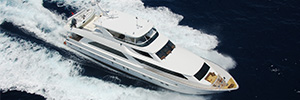Safeguarding electrical performance and safety on a yacht

Yachts present a number of very specific Power Quality challenges. Weak electrical installations combined with numerous non-linear loads greatly affect the Total Harmonic Current (THC) injected at the main power supply. This can result in distortion of the voltage waveform, leading to:
- breakdown of sensitive equipment,
- decreased lifespan of equipment,
- overloading,
- capacity losses,
- malfunction of instruments
- increased temperature in cables leading to a fire hazard
The Challenge
A yachting customer asked HyTEPS to perform harmonic load flow simulations to analyze and identify the magnitude of harmonic pollution in their electrical
installation. The magnitude of distortions in weak installations is notably high in absence of a harmonic mitigation solution. To avoid malfunctions – and for safety reasons – strict regulations proposed by Lloyd’s Register have been imposed to limit the Total Harmonic Distortion in voltage (THDu) to a maximum of 8%. Electrical installers are obliged to comply with this. However, as an expert in Power Quality, HyTEPS strongly recommends limiting THDu to below 3% as a precaution against
elevated risks at a THDu above 5%.
“In this case, the customer specifcally required that THDu be limited to below 5%,” explains Arnau Sans, Lead Engineer. “Based on provided data such as the single line diagram, thruster and generator characteristics, as well as a complete overview of installed loads on board, simulations were performed. The goal was to obtain a clear picture of the voltage and current waveform distortion for six different case scenarios. These take into account the mode of operation (number of active generators), type of operation (anchoring, maneuvering, sailing), load type (linear / non-linear), load usage, number of people on board (crew / guests) and weather conditions (winter / summer).
Objective
- Define harmonic distortion levels based on different case scenarios
- Propose size of active harmonic fltering needed to stay within 5% THDu limit
Solution
The analysis revealed that the electrical installation did not comply with Lloyd’s limit or the limit specified by the customer. An increased harmonic current distortion from Variable Frequency Drives (VFDs) with THC mainly comprised of 5th, 7th, 11th and 13th harmonic order was the main source of harmonic pollution. VFDs are highly non-linear loads used to control AC motor speed and torque. In yachts, VFDs are mainly used to control thruster motors and compressors in chillers. In the case scenario simulating the maneuvering operation, with guests and crew present, and three generators and chillers active during summer, the THC reached a maximum of 168.1A with a THDu as high as 8.13%!”
“HyTEPS provides solutions for installations that do not comply with the Lloyds limit using high-tech Active Harmonic Filters (AHFs). These reduce the THDu by measuring the harmonics in the main busbar and injecting back counter-harmonics to compensate for the signifcant harmonic currents at that location. Based on the worst-case scenario, the AHF was dimensioned to comply with the customer-specifed limit.” From the simulation results, we concluded that a 240A AHF was required to maintain the THDu between 1.45% to 2.4% – well below the 5% customer-specifed limit. Apart from harmonic fltering, this solution provided additional capacity for load balancing and power factor correction. The extra capacity also reduced stress on the flter by eliminating overloading, thereby increasing the longevity of the filter components.
Results
A detailed report covering all important aspects of the project – particularly the methodology behind AHF dimensioning, assumptions, conclusions and recommendations – was sent to the customer to support their decisionmaking. The customer decided to install the recommended 240A flter, which was ordered and delivered by HyTEPS. This was followed by a pre-commissioning to verify the functional operability of elements within the system and achieve a state of readiness for commissioning. Finally, a HyTEPS engineer visited the yacht with the installed flter for a sea trial, commencing the fnal stage of commissioning in which different test scenarios are performed to ensure the reliability and functionality of the AHF.
Arnau: “As a team, we are proud of our ability to help customers improve and excel, using our knowledge in the feld of Power Quality. For the customer, the importance of Power Quality in an installation has become very clear. So have the potential damages and costs incurred due to harmonics and the fact that Power Quality issues will only increase as more non-linear loads emerge in the future. Customer feedback on the installed AHF has been very positive, and no problems have been reported since commissioning.
Feedback on installed AHFs has been very positive, and no problems have been reported since commissioning